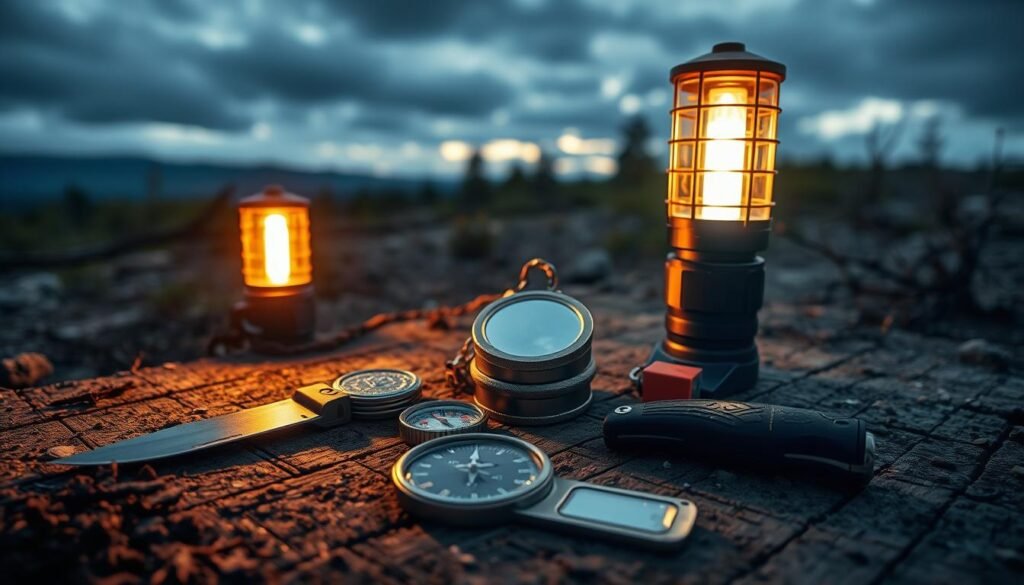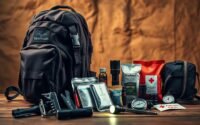10 Must-Have Survival Gear Items for Any Emergency
Nearly 40% of outdoor incidents happen within a day’s travel from the trailhead, and being ready can change the outcome fast.
You need a practical list that builds confidence and keeps you safe whether you are at home, in your car, or off-grid. Start with proven essentials: a compact first aid kit like the Uncharted Supply Co. Basecamp, reliable navigation such as a Garmin unit, and a satellite communicator like SPOT for messaging and SOS.
Plan for redundancy. Carry multiple ways to make fire, store water, and light your path. A rule of thumb is 1–2 gallons per person per day and portable reservoirs like Hydrapak make that manageable.
Smart planning outweighs flashy purchases. Balance compact, high-utility tools with backups and practice map-and-compass skills alongside modern tech. Bookmark this page and return — we update recommendations and tips regularly to keep your prep current.
Key Takeaways
- You’ll get a prioritized list to help you prepare for sudden incidents.
- Focus on medical, navigation, communications, water, fire, shelter, and signaling.
- Use modern tools like Garmin and SPOT while keeping classic skills ready.
- Plan 1–2 gallons of water per person each day and use rugged reservoirs.
- Redundancy and practice matter more than buying the most expensive item.
Start Smart: Planning, Risk Assessment, and Mindset for Any Emergency
Good planning turns a risky outing into a manageable situation before the sun sets. Begin with simple threat mapping and honest choices about your route and goals.
Prioritize threats
List likely hazards: dehydration, exposure, injury, getting lost, and communications failure. Match each to a mitigation such as water storage, rapid shelter, layered clothing, a robust first aid kit, navigation, and a comms plan.
Build a trip profile
Define location, duration, distance from help, group size, and weather. Let those factors drive weight, redundancy, and training priorities. Assume no cell service and plan check-ins with a satellite messenger and paper backups.
| Trip Profile | Key Kit | Prep Action |
|---|---|---|
| Short day hike | Basic first aid, map, water bottle | Set check-in time; 1 day water |
| Backcountry overnight | Extra water, shelter, satellite comm | Pre-stage purification; role assignments |
| Family car outing | Shared kit, layers, spare food | Pre-brief family rendezvous |
Scale your plan to group needs and backcountry risk, and pack a survival kit sized to the case you expect. Keep your mindset flexible: prioritize life safety over itinerary when situations change.
10 Must-Have Survival Gear Items for Any Emergency
A compact, prioritized kit gives you practical choices when plans change and time is short.
Below is a clear list of essential items and why each matters. Training and practice make these tools useful when seconds count.
Medical essentials
Carry a well-stocked first-aid kit sized to your group. The Uncharted Supply Co. Basecamp 30L is built to support a family of four with organized compartments and durable cases.
Navigation stack
Use a paper map and baseplate compass as the baseline. Add a Garmin Tread 2 GPS with offline maps and saved waypoints to confirm position in low visibility.
Emergency communications
Choose satellite messengers like SPOT for tracking, two-way messaging, and SOS. Preprogram contacts and agree check-in times before you go.
Water security
Plan 1–2 gallons per person per day and carry a Hydrapak reservoir. Pack filters and tablets as layered purification backups.
Fire starting redundancies
Bring at least two ignition methods: lighter plus ferro rod, sealed matches, and protected dry tinder to improve success in wet conditions.
Shelter and warmth
Include a tarp, a compact space blanket, and extra insulating layers to manage exposure and stabilize injured partners.
Light and signaling
A hands-free headlamp like the Biolite Dash 325 is best for tasks. Add a signal mirror and whistle to boost daytime detection.
Cutting and tools
Pack a fixed-blade knife (Benchmade) and a compact multi-tool. Add a basic mechanic roll (Adventure Tool Company ShopRoll) for repairs.
Cordage and repair
Carry 550 paracord and a small repair kit with tape and patches to build shelter, splints, and emergency fixes.
Sustenance add-ons
Include calorie-dense rations and a minimalist fishing kit with line and hooks to supplement food if delayed.
Proper planningand the right training boost the value of every tool. Bookmark this guide and review your kit regularly.
| Use Case | Core Kit | Key Extras |
|---|---|---|
| Day hike | Small aid kit, map/compass, Hydrapak | Headlamp, lighter, paracord |
| Backcountry overnight | Basecamp 30L, Garmin Tread 2, SPOT | ShopRoll tools, extra layers, fishing kit |
| Family car | Shared kit, tarp, space blanket | Spare water, fire kit, signal mirror |
Medical, Navigation, and Comms: The Life-Saving Core
When minutes count, a well-organized medical pack and reliable communications keep everyone safer and calmer. Take planning seriously: medical readiness and a clear check-in routine cut response time and reduce panic.
First aid kit loadout for day trips, backcountry, and families
Tailor your first aid to trip type. For day hikes carry basic bandages, blister care, and antiseptic. For backcountry routes pack gauze, triangle bandages, meds, gloves, and trauma supplies.
The Uncharted Supply Co. Basecamp 30L scales to support a family of four and organizes bleeding, fracture, and wound care so you can act fast.
Map and compass skills plus GPS waypoints and offline maps
Carry a paper map and a compass and practice plotting bearings and triangulating positions. Use a Garmin Tread 2 to save waypoints and load offline maps as an electronic backup.
When cell service fails: satellite communicators and check-in routines
Assume service will drop. Bring a SPOT satellite messenger, preprogram SAR contacts, and set fixed check-in times with someone at home.
Keep spare power and a paper backup of key info in your aid kit so dead batteries never become a single point of failure.
Water, Food, and Fire: Sustain Yourself for Days
Sensible provisioning of water, food, and reliable ignition keeps you going when delays happen. Plan ahead so you don’t improvise life-support on the trail.
How much water to carry per person per day
Calculate at 1–2 gallons of water per person per day and add margin for heat or heavy exertion. Confirm refill points on your route and carry extra if sources are scarce.
Purification choices: filters, purifiers, and tablets as backup
Choose a primary filter or purifier based on expected contaminants: filters remove particulates; purifiers protect against viruses. Always carry tablets as a failsafe.
Stage your water purification: prefilter turbid sources, run them through your filter or purifier, then store in clean containers. Combine a large reservoir (Hydrapak 10L) with on-the-move bottles so a single failure won’t lose your supply.
Fire in bad weather: layering methods and safe ignition
Build redundancy: lighter, sealed matches, and a compact ferro rod. Carry dry tinder from home, use feather sticks or shavings, and progress to larger fuel while shielding the flame from wind and rain.
Practice safe ignition and fire management before you need it. Pack calorie-dense, no-cook food and electrolytes, rehearse a no-stove plan, and keep a sealed emergency starter dry. Meticulous planning for these basics improves your odds and keeps your group calmer during extended survival scenarios.
Shelter, Clothing, and Heat Management in Changing Weather
Exposure is often the fastest threat to your health; shelter and layering cut risk quickly.
Hypothermia can occur around 50°F, especially when you are wet. Pack a compact space blanket and extra synthetic layers to help your body hold heat.
Rapid-deploy shelter basics
Have a plan to get out of wind and rain fast. A tarp or a large contractor bag rigged as a lean-to with paracord works well.
Warmth, dry feet, and head protection
Carry an extra pair of socks and a warm beanie. Change into dry socks before rest to conserve heat and protect circulation.
- Use moisture-wicking synthetics or wool; avoid cotton that holds water.
- Keep a minimal sleep system or an emergency bivy in your kit to buy time at night.
- Practice lean-to and A-frame pitches at home so you can work quickly under pressure.
Stay ahead of exposure: add layers early, vent when you work hard, and manage sweat so you stay warm when you stop moving.
| Need | Quick Solution | Why it matters |
|---|---|---|
| Wind or rain | Tarp/contractor bag + paracord | Blocks wind and keeps you dry to prevent rapid heat loss |
| Stationary injured person at night | Space blanket + extra layers | Reflects body heat and slows hypothermia |
| Wet feet or cold head | Spare socks + beanie | Protects extremities and preserves core temperature |
Thoughtful preparation for exposure is critical; check back often for updated layering and shelter recommendations and update your kit after each trip.
Tools, Lighting, and Signaling to Get Unstuck and Get Found
When your route goes sideways, reliable tools and clear signals decide whether you get unstuck or stay stranded. Serious preparation includes durable kit choices and simple signaling methods you can trust.

Knife selection and maintenance for backcountry reliability
Choose a sturdy fixed-blade knife over a folder for heavy chopping, batoning, and carving. A fixed blade holds up under stress and is easier to clean in the field.
Keep a small sharpener in your repair pouch and rust-proof blades after use. A compact mechanic tool roll like the Adventure Tool Company ShopRoll complements a knife for repairs.
Headlamps over handhelds: hands-free safety at night
Choose a lightweight headlamp such as the Biolite Dash 325 so your hands stay free for navigation and first aid at night. Pack spare batteries or a small power bank.
Add a backup flashlight or button light as redundant light so a single failure won’t leave you blind.
Mirrors, whistles, and smoke: effective daytime and nighttime signals
Use a signal mirror for long-distance daytime signaling (visible up to about 15 miles on clear days) and a loud whistle to conserve energy while attracting attention.
Carry cordage like 550 paracord and consider vehicle recovery gear (Warn winch and rated points) when remote roads may require self-recovery.
We’ll keep updating this section with proven options—bookmark it.
Pack It Right, Keep It Ready, and Keep Learning
Smart staging of supplies lets you grab exactly what you need in minutes.
Organize by scenario. Build modular kits for home (72-hour), vehicle, and backpacking so you can grab one loadout without repacking. Keep clear pouches labeled medical, water, fire, shelter, and tools to speed access under stress.
Keep at least three days of water and food staged per person in both your home and vehicle. Hydrapak foldable reservoirs save space when empty and fit into dead space in trunks or packs.
Inspection cadence
Rotate water and food on a calendar schedule. Test batteries and run scheduled SPOT test messages. Update offline maps on a Garmin Tread 2 and flash device firmware before each season.
Skill-building
Practice fire, navigation, and first aid regularly. Create short drills: build a fire from damp wood, navigate to a waypoint, and run a triage scenario with your family.
| Setup | How Often | Key Action |
|---|---|---|
| Home 72-hour | Quarterly | Rotate food/water; check first aid; label pouches |
| Vehicle kit | Every 6 months | Refill reservoirs; test lights; secure case |
| Backpacking pack | Before each trip | Confirm map waypoints on Garmin; top off batteries |
- Standardize core items across all kits (headlamp, knife, cordage) to cut decision load.
- Keep quick-access essentials on top or on your person.
- Document lessons after outings and add one skill or upgrade each month as an addition to your plan.
Plan and practice. Regular checks and small, steady improvements keep your survival kit and gear ready when you need them most. Bookmark this guide and return for updated packing lists and training resources.
Conclusion
A clear plan and practiced skills let you respond calmly when conditions change fast. Keep a compact kit that matches how you travel and stage three days of food and 1–2 gallons of water per person. Pair GPS waypoints and offline maps with a paper map and compass.
Carry a satellite communicator, a capable first-aid kit, and multiple ways to start a fire. Add a tarp and a compact space blanket, a reliable headlamp, mirror, and whistle to boost your signal options at night.
Bring a fixed-blade knife, cordage, basic tools, lightweight rations, and a small fishing line/hooks set as low-weight backups. Rehearse how each tool works, review your kit before each trip, and update supplies after every outing.
Proper planning and steady practice are non-negotiable. Bookmark this guide, share it with family, and schedule a skills day so you stay ready for real situations.
FAQ
What core items should you prioritize when building a compact emergency kit?
Start with water storage and purification, dependable shelter like a tarp or space blanket, reliable fire starters (lighter plus ferro rod), a quality fixed-blade knife or multi-tool, and a well-stocked first aid kit. Add a headlamp, cordage (paracord), basic repair tape, and compact high-calorie rations. Those elements cover hydration, warmth, signaling, cutting, and medical needs.
How much water should you plan per person per day?
Plan on at least one gallon per person per day for drinking and basic sanitation in most climates. In hot or active conditions, increase that amount. Carry a small emergency supply plus a purification method—pump filter, gravity filter, or tablets—so you can use natural sources safely if you run low.
What navigation gear do you need if you go off-grid?
Carry a paper topographic map of the area, a reliable compass, and a GPS device or smartphone with offline maps and saved waypoints. Practice using the map and compass; batteries and signals can fail, so the analogue skills are essential for backcountry reliability.
Which communication options work when cell service is unavailable?
Satellite messengers (like Garmin inReach) and personal locator beacons (PLBs) provide global SOS capability. Handheld VHF/UHF radios help for short-range group comms, while a whistle and signal mirror offer immediate visual and audio signals for rescuers in your vicinity.
What should a practical first aid kit include for day trips and family use?
Include bandages, adhesive tape, sterile gauze, antiseptic wipes, trauma dressing, and a compression bandage. Add pain relievers, antihistamines, tweezers, a SAM splint or immobilizer, and any personal prescriptions. Learn basic first-aid and refresh those skills regularly.
How do you ensure you can start a fire in wet conditions?
Use redundant fire starters: a butane lighter, stormproof matches in a waterproof case, and a ferrocerium rod. Pack dry tinder alternatives like cotton balls soaked in petroleum jelly or commercial tinder tabs. Practice layering kindling and using a sheltered fire lay to protect the flame from wind and rain.
What shelter options are best for lightweight and rapid deployment?
A lightweight tarp with cordage provides fast, versatile shelter. Space blankets and emergency bivvies add compact warmth. For very short trips, contractor trash bags can create quick rainproof shelters. Choose options that match the climate and your ability to rig them quickly.
How often should you check and refresh your emergency kit supplies?
Inspect your kit every three to six months. Rotate food and water before expiration dates, test batteries in flashlights and radios, check seals on fuel and lighters, and replace perishable medical items. Update maps, contact lists, and any medications as needed.
Is cordage really necessary, and how much should you carry?
Yes. Paracord serves many roles: shelter rigging, gear repair, tourniquets, and improvised traps or fishing setups. Carry at least 50–100 feet of 550 paracord in a compact coil or woven into your kit for quick access.
Are fishing line and hooks worth including in a survival kit?
Lightweight fishing gear is a valuable sustenance add-on. A small spool of monofilament, several hooks, sinkers, and a few leaders take up little space and can yield protein when other food runs out. Pair it with basic knowledge of local fishing regulations and techniques.
What lighting and signaling tools should you pack to improve chances of being found?
Prioritize a headlamp for hands-free use and a compact, high-output flashlight as backup. Add a signal mirror, whistle, and a chemical light stick for night visibility. Bright, reflective materials and the ability to create smoke signals in daylight enhance your visibility to rescuers.
How do you balance kit weight with capability for backpacking vs. vehicle kits?
For backpacking, prioritize lightweight, multi-use items: a compact stove, ultralight tarp, small filter, and a lightweight knife. In a vehicle kit, include bulkier items like extra water, a full tool set, heavy-duty tarp, and larger first-aid supplies. Tailor contents to the environment and likely scenarios.
What basic tools should you include to handle mechanical or gear failures?
Pack a small multi-tool, a compact set of screwdrivers or hex bits, duct tape, spare cordage, and a pocket-sized roll of repair tape. For vehicle kits, add jumper cables, a tire repair kit, and a compact folding shovel. These tools let you fix common issues in the field.
How do you practice and maintain the skills needed to use your kit effectively?
Schedule regular skill sessions: practice navigation with a map and compass, build fires with each starter method, run first-aid scenarios, and set up shelter quickly. Join a local outdoor skills class or take a Wilderness First Aid course to keep knowledge current and confidence high.


